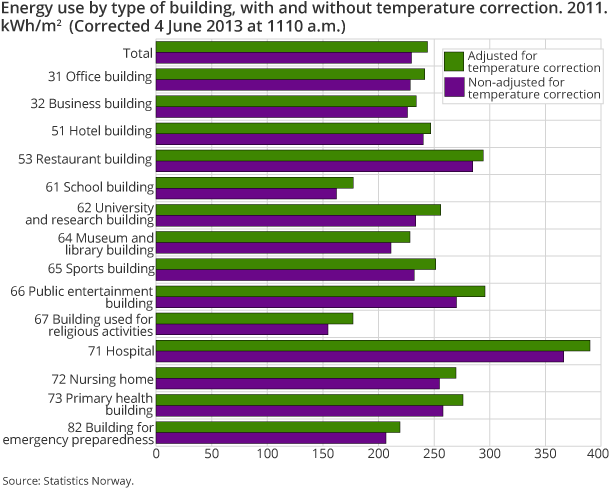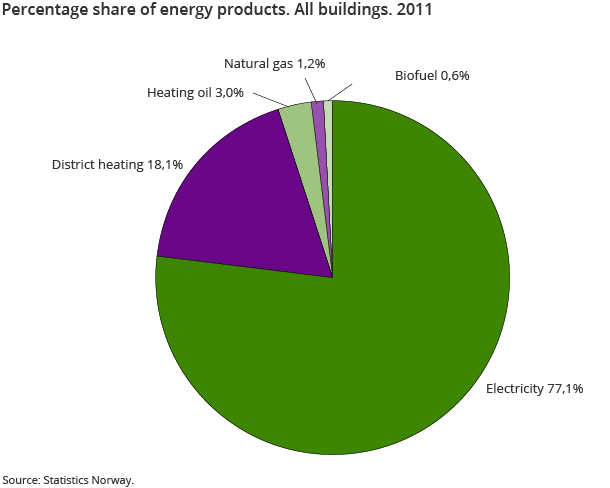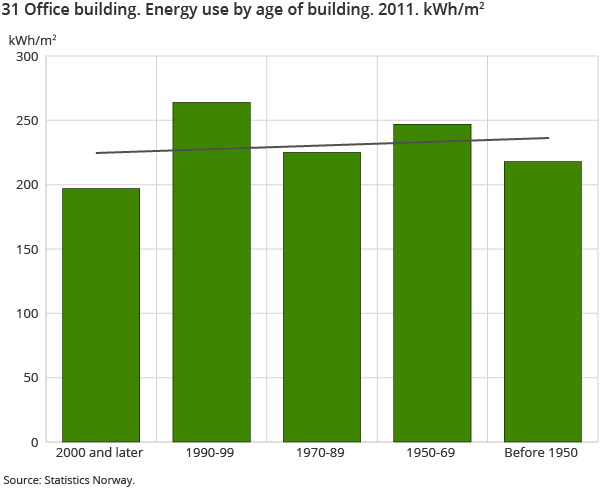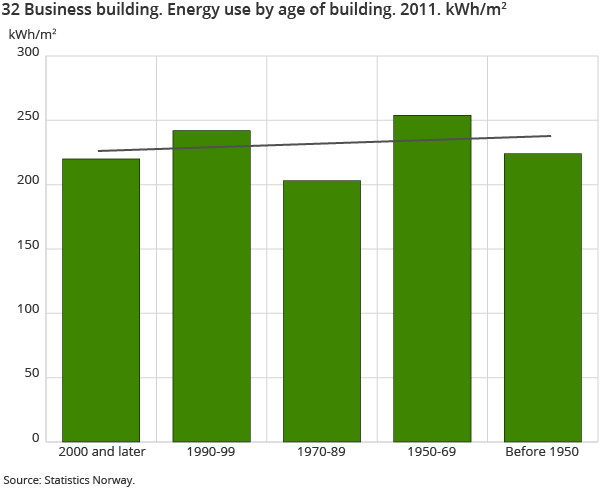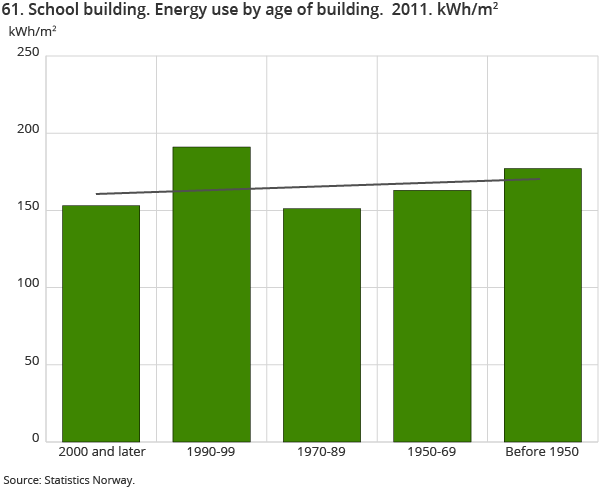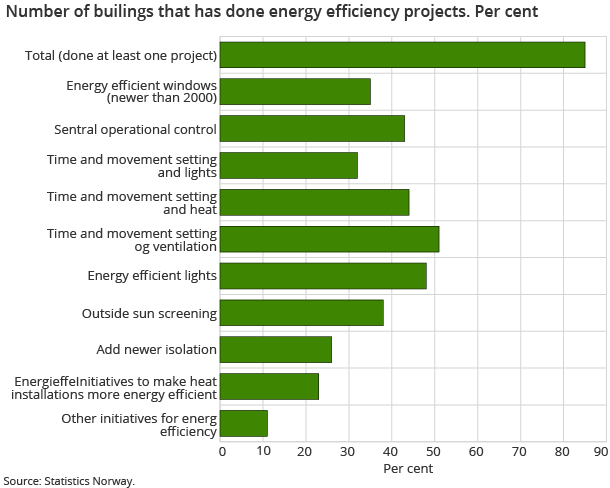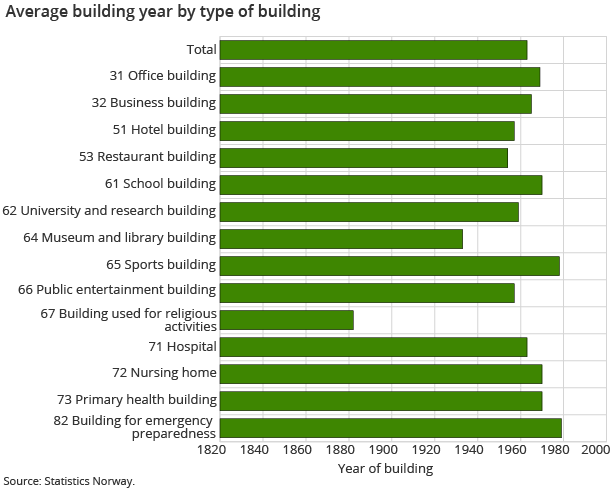Content
Published:
Low energy use due to mild weather
In 2011, the average energy consumption in industrial buildings within service industries was 230 kWh/m2. Adjusted for temperature, energy use was 244 kWh/m2. The energy use in hospitals was among the highest.
| 2011 | ||||
|---|---|---|---|---|
| Total | Electrisity | District heating | Other | |
| kWh/m2 | Percentage share | |||
| 1Building types are classified according to the Norwegian standard, NS 3457, for building types (Martikkelen). | ||||
| Total | 230 | 77.1 | 18.1 | 4.8 |
| 3 Office and business building | 228 | 80.7 | 16.4 | 2.9 |
| 5 Hotel and restaurant building | 242 | 76.9 | 16.6 | 6.5 |
| 6 Building used for education, public entertainment and religious ativities | 190 | 76.1 | 17.1 | 6.8 |
| 7 Hospital and institutional care building | 313 | 71.4 | 23.2 | 5.3 |
| 8 Prison, building for emergency preparedness etc. | 207 | 79.9 | 12.3 | 7.8 |
Temperature is an important variable in explaining energy use. In 2011, the average temperature for Norway was 1.8 degrees Celsius above the normal temperature for the period 1961–1990. The energy use adjusted for temperature illustrates how high the use of energy would have been with normal temperatures. For 2011, the energy use adjusted for temperature was 6.3 per cent higher than the corresponding figure non-adjusted for temperature.
High energy use in hospitals
The statistics show large variations in energy use per square metre between and within different building types. This can be explained by differences in building constructions, area of application, the amount of electrical equipment and the scope of energy efficiency measures implemented. Buildings with a high energy use had extremely energy-intensive equipment, while those with a very low energy use had limited technical equipment and a short period of use.
The energy use in hospitals was among the highest, at 375 kWh/m2 in 2011 (not adjusted for temperature). Schoolhouses and kindergartens are among the building types with the lowest energy use per square metre. Primary schools and upper secondary schools used on average about 150 kWh/m2.
Electricity and district heating the largest energy sources
The largest energy source in most building types is electricity (on average 77 per cent), but for some buildings district heating accounts for a substantial share of total energy use. The building types that use a high share of district heating include universities, colleges and sports centres. The share of district heating accounted for 18 per cent of total energy use in buildings. Heating oil is also used in some buildings, but accounted for just 3 per cent of total energy use. Other energy sources, such as pellets and gas were important energy sources for some large buildings. However, in total, these energy sources accounted for only a minor share of total energy use. Results also show that the use of wood is not common in industrial buildings.
Slightly lower energy use in newer buildings
There is no strong relationship between a building’s age and energy use, but some of the building types best represented in the survey have a slightly lower energy use in newer buildings. Increased demands for better comfort and indoor climate can partly explain why the energy use in newer buildings is not lower.
Central heating an important heating source
About 50 per cent of the buildings in the sample had central heating as their main heating source. Buildings with central heating had a higher energy use in most building types than those without central heating.
Heat recovery ventilation system most common
About 70 per cent of the buildings had balanced mechanical ventilation with heat recovery as the main source of ventilation. Five per cent had balanced mechanical ventilation without heat recovery, and ten per cent had a mechanical exhaust ventilation system. Fourteen per cent had natural ventilation as the main source of ventilation.
Based on a survey of 6 100 buildingsOpen and readClose
The statistics are based on a survey of 6 100 buildings. A total of 5 200 buildings responded to the survey, while a little more than 2 800 buildings had approved energy and buildings data and form the data source for these statistics.
Contact
-
Statistics Norway's Information Centre
E-mail: informasjon@ssb.no
tel.: (+47) 21 09 46 42

